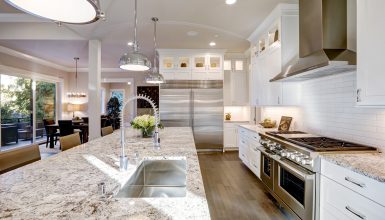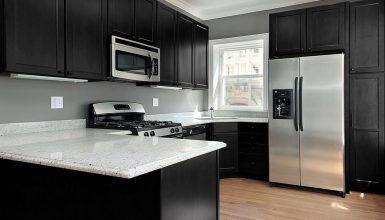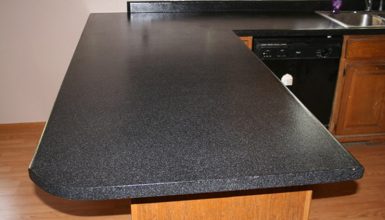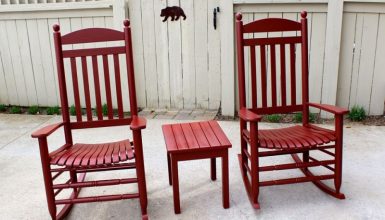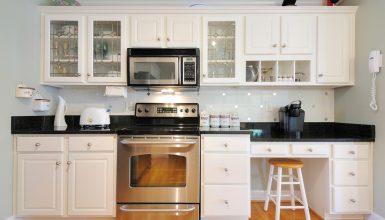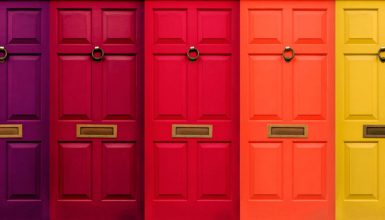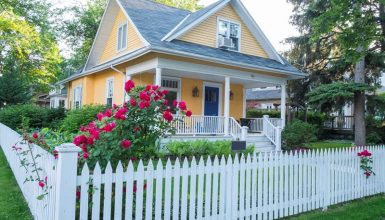Chalk Paint’ is a term trademarked by ‘Annie Sloan’, a British artist and color expert for her range of environmentally friendly decorative paints that can be applied on furniture without sanding or priming it.
However, the term has largely become synonymous with any mineral based paint that’s used to give furniture, a matted and distressed look.
It has a very distinctive appearance and part of the appeal is that due to the fast drying, it can be used just about any time to give your furniture a cheap but very effective makeover.
A matted finish, but one that can be distressed in minutes, for even new furniture pieces.
Give it a coat of wax and it develops a natural soft lustrous finish that some people find even more appealing.
DIY forums, Instagram and Pinterest are crammed with photographs of furniture pieces that have been restored/remodeled using chalk paint.
Therein lies the popularity among DIY buffs like myself. There are tons of ways in which you can customize a furniture piece with chalk paint. The finishes can be tailored to look crusted, old, chipped or plain smooth.
The Best Chalk Paint for Furniture








For a long time, the market was dominated by one single brand, Annie Sloan. However, that’s no longer the case now. There are numerous brands that compete against each other by offering better quality, a broader color palette and cheaper price tags. Well, we certainly aint complaining.
1. Renaissance Chalk Paint

Most people would have expected us to begin with Annie Sloan.
After all, that’s the brand that’s synonymous with chalk paint all around the world.
But Renaissance Furniture, a little-known brand from North Carolina offers a whopping 40 different colors in their range of chalk paint.
That’s the broadest color palette amongst any chalk paint brands that we’ve known. And it’s not limited to the wide selection either.
Their chalk paint contains zero VOC. All other brands are certified for ultra-low VOC. So, that’s another feather in their cap.
Quality-wise, the paint is second to none. If anything, it’s a tad thicker than most. This eliminates the need for any priming or sanding as the adherence is excellent. The coat is chalky and smooth and with a little skill, you can easily replicate the famous shabby-chic finish.
The caveat is that you can’t expect to use this with a spray gun. It will only work with a roller and a brush. Also, it tends to clump unless you dilute it a little.
Due to the thicker consistency, it offers slightly lesser coverage than some of the other brands in this list of best chalk paints for furniture. But that’s a minor quibble and certainly not a deal breaker.

Renaissance Furniture backs up the amazing quality with a very competitive price tag, that’s cheaper than most other brands in the market currently.
Pros
- With 40 colors, it has the broadest color palette to choose from
- Cans available in a variety of sizes (8,16,32,128 oz.)
- Certified for Zero VOC
- Excellent adherence without priming
Cons
- Needs to be diluted to be used with a spray gun
- Lesser coverage per can as compared to the competition
With a great price tag, the best color palette and certified for Zero VOC, Renaissance Furniture paints is certainly a very worthy contender for the best chalk paint for furniture.
2. Rustoleum Chalk Paint

We have used Rustoleum’s automotive products in the past and some of the products from their ‘Transformations’ range more recently.
So, we were disappointed to know that they have only 8 color choices in their palette.
But that’s expected considering that the brand is not focused on the consumer paint industry as much as some of the others in this list are.
Having said that, the quality of their chalk paint is phenomenal. Offers excellent coverage. We measured 150 feet+ (single coat) from a single can and still had a little left in it. There is no odor and it dries in less than 30 minutes. However, we recommend that you wait for an hour or two before you go at it again for the second coat.
The finish is a deeper matte than the Renaissance or the Annie Sloan one. Also, it comes in a spray can. Yay!
With the coverage and the thin consistency, this is one of the few chalk paint brands that you can bravely step in the outdoors with.
Did we forget to mention that it’s cheaper than most other brands?
The only possible nit that we could pick with it is that it needs surface priming before applying. Well, you can’t get it all, can you?

Pros
- Excellent coverage
- Available in a spray can
- Deep matte finish
- Quick drying formula
- No odor
- Less expensive than other brands
Cons
- The surface needs to be primed
- Only 8 colors
With a thin consistency that lets you use a spray gun and the excellent coverage, the Rustoleum Chalk Paint saves you time and effort. The finish is smooth and the pricing is very reasonable. The only let down is the limited color palette.
3. Annie Sloan Chalk Paint
No products found.I bet you were waiting for this with bated breath. Here’s Annie Sloan, the original chalk paint brand that started it all.
In fact, we could say that this one is the Sherwin Williams of the DIY paint world.
It ticks all the boxes that one looks for while selecting a chalk paint for furniture, or even for general home use.
It is environmental friendly, has minimum VOC, is available in 36 colors, has a unique acrylic based content that allows even coverage and consistency and one can provides about 150 sq. ft. of coverage.
The paint is thicker than the Rustoleum. But not as thick as the Rennaisance Furniture Chalk paint. This translates into excellent adherence without any priming.
There’s tons and tons of literature, demo videos and DIY projects using this chalk paint. Annie herself shares a lot of tips and tricks. So, you’ll never have a dearth of support resources to refer to.
Let’s talk about the quibbles that we have with the brand. It is more expensive than any other brand in this list of best chalk paints. That’s given considering their reputation and their massive fan following.
Also, you will need to use a wax coating or any other protective finish of your choice with this. The manufacturer recommends the Annie Sloan Wax. But that’s a subtle cross-sell right there. Just about any one works.
Pros
- Proven results and reputed brand
- Great quality paint with a smooth finish
- Multiple-sized cans available
- Incredibly easy to clean
- Non-toxic and environment friendly
- No priming needed
- Tons of support resources
Cons
- More expensive than other brands
- Needs a protective top coat
You can’t go wrong with Annie Sloan chalk paint. It is backed by years of proven performance and an entire community of DIY enthusiasts. Unless you are shopping on a limited budget, you’d be hard pressed to find a better choice.
4. FolkArt Chalk Paint

What would we do in ‘Arts & Crafts’ class without Plaid?
These are the guys behind some of the most widely used brands in the Arts and Crafts Hobby industry including Mod Podge, Apple Barrel, Gallery Glass, Martha Stewart and of course, FolkArt.
That’s one of the reasons why this teensy little can (8 oz.) of chalk paint caught our attention. After testing it out, we discovered that this is a good quality chalk paint with a few idiosyncrasies that one must be willing to overlook.
Have a small piece of furniture that you’d like to paint? This is the best chalk paint for you. It’s a small bottle. It’s way cheaper than any other brand here. The quality is excellent and the color palette is elaborate. You have 42 colors to pick from.
The paint is thick, does not need priming and has a deep-matte finish like the Rustoleum Chalk paint. But, the thickness hinders its drying time. This takes close to an hour to dry. Add a couple of hours to it before you are allowed to go at it again. Last but not the least, you get barely 20 square feet of coverage from a single can. Remember what we said about smaller furniture pieces?

Pros
- Small-sized cans only which are excellent for small furniture projects
- Budget-priced chalk paint
- 42 colors in the palette
- Deep matte finish
- Non-toxic
- Slightly thicker consistency which improves adherence
Cons
- Takes almost an hour for the first coat to dry
- Only 20 square feet of coverage
Budget-minded shoppers and those looking for a small can of chalk paint won’t mind the minor niggles. Especially because the quality of the paint is pretty good and hey, it comes from FolkArt, a reputed brand.
5. Soft Southern Strokes Chalk Paint

Another locally-produced chalk paint line that we can’t stop raving about. Soft Southern Strokes from MS, USA is a high quality chalk paint that provides great coverage and a smooth chalky finish.
Created by Lisa James an amateur artist, the color palette has 30 color options, with a few custom ones that aren’t found elsewhere.
We loved the Blue Suede shoes and used it to restore an old dresser. Looked fab!
The formula is completely plant-based and hence, there are zero fumes. We mean, absolutely no odor at all.
It provides very good coverage, dries in about 45 minutes and is available in a both large and small-sized cans, allowing you to choose the right one based on your project requirements.
If it were us, we’d always get the bigger can. You will surely fall in love with this. Very reasonably priced too!
They also have a DIY chalk powder that you can use to create your own chalk paint. If you are smitten by the DIY make-your-own-recipe bug, here’s an easier route for it.

Pros
- Locally made in the USA
- 30 color options
- Available in various sizes
- Plant-based formula with zero odor
- No fumes
- Dries in 45 minutes
- Thick, even consistency
Cons
- Like the rest of the chalk paints that are slightly thicker in consistency, this does tend to clump a little. Just keep stirring to prevent this from happening.
We are all for supporting local communities and small niche businesses. Especially, when the quality of the product rivals much higher priced brands. Do give Chalk it, a test run at least. We are sure you won’t regret it.
Chalk Paint vs. Milk Paint
However, people often mix up chalk paint with milk paint, which is an entirely different type of paint altogether.

The most important difference among chalk paint and milk paint lies in the ingredients.
Milk paint is made by forming a powdered mixture of limestone, clay, pigment and casein. You then mix it with water to form a paint that’s slightly thinner as compared to chalk paint. It is completely non-toxic and can be used anywhere in the house.
Chalk paint on the other hand is usually made from a mixture of calcium carbonate, talc and natural color pigments. It is available in a premixed liquid form and comes ready-to-use out of the box. Chalk paint may or may not be non-toxic depending on the ingredients used and the VOC levels.
Now let’s compare the two in terms of ease of use, aesthetics and price.
Ease of use
- Milk paint must be mixed manually with water depending on how thin or thick you want the consistency to be. It may take multiple passes before you are able to achieve uniform coverage. Also, it peels and flakes a lot sooner than chalk paint making it ideal for antique furniture pieces more than newer ones.
- Chalk paint on the other hand offers more control. It is thicker and does not peel or flake easily. Instead, you can sand it to achieve the distressed look that you seek. Also, even a quart can will offer excellent coverage. Little is way too much with chalk paint.
Chalk paint is clearly, easier to use than Milk paint.
Aesthetics
We know what just popped up in your mind. How can we rate something on aesthetics?
That’s subjective, isn’t it? Yes, it is.
The fact is that while both types of paint offer a very similar, matte distressed finish, chalk paint, especially
Annie Sloan’s range, offers a much wider color palette and finish options.
Also, the finish is more uniform as we mentioned earlier.
To achieve the same consistency and results with milk paint might be a tall order.
We are by no means saying that it cannot be done.
But it will probably involve a lot of mixing, trial and error, constant stirring and bonding agents before you can achieve some amount of consistency with milk paints. On its own, it’s as unpredictable as it gets.
Oh, also, good luck with trying to hide those brush strokes.
Having used both types of paints extensively, we are of the opinion that chalk paint edges out milk paint when it comes to aesthetics and finishes.
Price
This is where milk paint scores way ahead of chalk paint. It is cheaper.
The average cost to cover about 75 square feet with milk paint is $25-30
Chalk paint on the other hand, costs about $40 a quart depending on the brand and where you buy it from. But it can easily cover almost 150 square feet. That’s an often overlooked factor when people compare the price points of the two types of paints.
Before making a beeline to the store, you must also consider the effort that you need to put in to get the perfect finish with milk paint and the fact that it doesn’t offer as much coverage as chalk paint does.
How to Paint Furniture Using Chalk Paint?
Each and every DIY buff will probably have their own secret chalk paint recipe and set of techniques to share.
But personally, we’ve felt that making our own chalk paint is so not worth the hassle and effort.
Instead, we pick a color from one of the best chalk paint brands which we will share with you in a bit and start working on our furniture pieces.
So, if you are wondering how that old, beaten furniture piece gets transformed into that stunning matted art piece with a hint of distress in the right places, here you go.
#1 – Pick a furniture piece
You can pick any furniture piece at home, that can do with a new coat of color, or you can pick one at a yard sale. The latter is usually the way we do it. If you are lucky and willing to spend a little time hunting, you can find some excellent wooden furniture pieces for throwaway prices. It doesn’t have to be old or vintage, although that’s recommended. Even a mass-produced one should work just fine.
#2 – Select the paint
You can pick one from any of the five best chalk paints that we have shared below. Each brand has a wide color palette on offer. We usually buy two different colors and test them out on a small inconspicuous part of the furniture before deciding on which one to use. If need be, you can even layer them to create a completely new color.
#3 – Gather your tools
You will be needing a few tools that you can either source from home or buy separately. This includes brushes, safety gear (just in case), painters tape, stirrer, screwdrivers, plastic knives, soft rags, can opener and wax, if you decide to go with a protective top coat.
#4 – Find your workspace
It is always recommended that you work indoors in a cool, airy and well lit place. While chalk paint is non-toxic and there’s no risk of fumes, a naturally airy place will allow the paint to dry faster. Working outdoors with chalk or milk paint can be tricky. Also, there’s always the risk of dust or debris settling on the newly painted surface.
#5 – Prepare the furniture piece
Start off by thoroughly cleaning and scrubbing off any debris or dust from the furniture piece. Run your hands over the entire piece to double check for any residual gunk or finger oils that might be left off. Old furniture pieces can hide these in the strangest of places. So ensure that you do not skimp on this. If there are any holes or dents, patch it up with wood glue. Remove the knobs and any other hardware. Remember, you don’t need to sand or prime the furniture for chalk paint. If there are any sections of the furniture that won’t be painted, like the interiors maybe, then tape it off.
#6 – Start painting
Use the can opener to open the first can of chalk paint and test it out by applying a small coat in an inconspicuous area. The underside of the furniture is our favorite testing spot. Now, test the other one by applying it next to your first swatch. You should be able to get a clear idea of which one works best. Now go ahead and apply the first coat evenly.
Tips for easy application
- Chalk paint is thick. But if it’s your first time applying it and you apply a bit too much or too little in some areas, then don’t fuss over it. You can go back and thin it out.
- You can work directly from the paint can.
- Always paint in the direction of the wood grain. You can use a stroke or two against the grain to increase the coverage though.
- The first coat will always have brush strokes and look patchy. That’s why you need a second coat when things magically start to fall into place.
- Chalk paint will dry in less than an hour. You should be ready to go with your second coat by then.
#7 – Time to distress the piece
Now, as unbelievable as it may sound, chalk paint looks good even without distressing the finish. So, do it only if you absolutely must. Use a medium-grain sand paper and with very gentle hands, test it out in the corners and edges. Don’t overdo it. Go slow and steady.
#8 – Use wax to seal it
We highly recommend waxing the furniture piece after you finish applying your last coat. No, it does not make it appear glossy. In fact, it gives it a very soft luster that only enhances the paint coat. So, go ahead and apply wax. It is easier than it seems to be.
Without further ado, here are our recommendations for the best chalk paint for furniture.
Conclusion
To take it home, it is the type of look you are aiming for, the size of the furniture piece and your budget that will determine the best chalk paint for furniture for you.
We have listed the best options that you have along with its pros and cons. We hope that this helps you make an informed decision.

